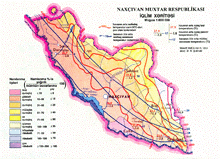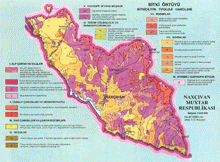Nature
Nakhchivan Autonomous Republic is located in the South-East of the Transcaucasus plateau. The average height above sea level is 1450 m.
 |
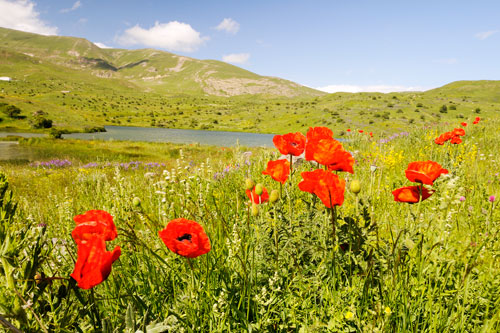 |
The most part of the territory of Nakhchivan Autonomous Republic is surrounded by the Zangazur and Daralayaz mountain chains of the Lesser Caucasus. The highest peak is the Gapichig mountain (3904 m). The plain lands along the Araz river (Sadarak, Sharur, Boyukduz, Kangarli, Nakhchivan, Julfa, Ordubad) constitute 1/3 of the territory. There are more than 200 mineral water springs (Daridagh, Badamli, Sirab, Vaykhir and others). While the annual precipitation is 200-300 mm in the plain lands along the Araz river, in the high mountainous places, it is 500-800 mm.
There are 400 big and small rivers in Nakhchivan Autonomous Republic the length of which is 1,8 thousand km. The type of the climate in Nakhchivan Autonomous Republic is mainly dry and continental. Its flora is very rich. There are 2782 kinds of higher plants and it has a rich fauna.
 |
 |
The Rivers - The Araz river, which takes its source in the territory of Turkey and makes the border of Nakhchivan with Turkey and Iran Islamic Republic, is the largest river flowing from Nakhchivan. There are about 400 rivers and river branches in the territory of Nakhchivan Autonomous Republic. The Arpachay, the Nakhchivanchay, the Alinjachay, the Gilanchay are considered as the biggest rivers in the territory of the autonomous republic.
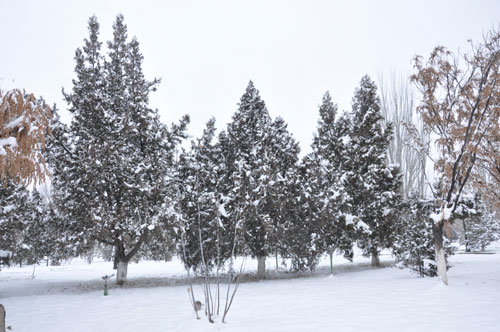 |
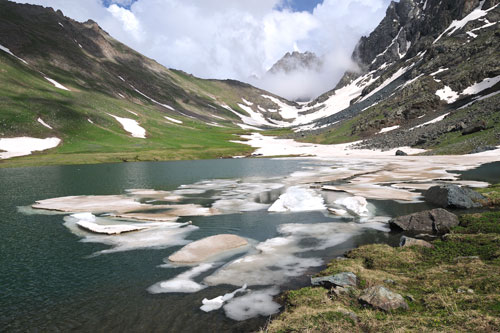 |
The Lakes - The natural lakes of Nakhchivan Autonomous Republic mainly belong to the valleys of Nakhchivanchay and Gilanchay. The Ganligol, the Batabatgol, the Salvartigol, the Goygol are the main natural lakes of the autonomous republic. The water reservoir named after Heydar Aliyev, the Araz, the Arpachay, the Bananiyar, the Nehram, the Uzunoba and other reservoirs were built in the rivers of Nakhchivan Autonomous Republic.
The mineral waters - 60% of the mineral waters reserve of Azerbaijan fall to the share of Nakhchivan Autonomous Republic. More than 250 mineral water sources were stated in 5,5 thousand km2 area of Nakhchivan Autonomous Republic. The mineral water sources “Badamli”, “Sirab”, “Vaykhir”, “Gulustan”, and “Narzan” are popular in the world.
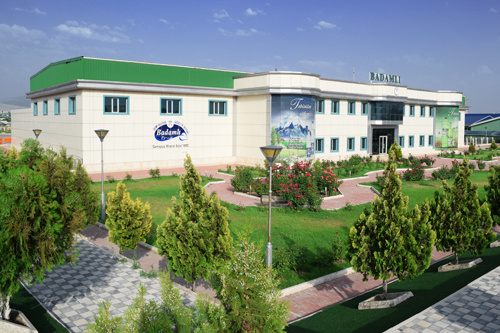 "Badamli"
"Badamli"
The source of this mineral water is situated in the wonderful valley covered with almond wood and vineyard, 1400m above sea level, at 30km distance of the city of Nakhchivan, around the village of the same name (Shahbuz region of Nakhchivan AR). The very place became popular for its carbonate water-narzan springs, daily output of which is 2,5mln liters.The water contains iodine, bromine, copper, borocic acid. One of the largest mineral water filling plants in the Caucasus operates here on the basis of the springs under the useage. “Badamli-5” is a wonderful beverage which capable to raise appetite, better digestive process, and stop the thirsty. This water does not have an analogy in treating digestive diseases out of resort houses condition.

"Sirab"
“Sirab” is a “Borjomi” typed popular healing-beverage water. This water is carbonated, hydrocarbonated-natrium-calcium with 2,0-2,7 g/l total mineral composition. Magnesium, bromine, and calcium acids, titium, stonsium were discovered in “Sirab”. On the basis of the utilized sources “Sirab-12” of aromatic healing-beverage water filling plant operates. This water is used in gastroenteric, urine secretion canal diseases, and also in metabolism disturbance. The water source is situated not far from the village of Sirab which is rather popular for the “Dashgala” architectural complex of the Bronze Age.
"Vaykhir"
Vaykhir is the richest deposit with Yesentuki type carbonated salt-alkaline waters, and it is situated at 17 km distance in the North from the city of Nakhchivan, 1400m above the sea level. Daily output of the drilled wells is more than 2mln liters. This water is carbonated, chloride-hydrocarbonated-natrium with 6,5 g/l total mineral composition. The water is used in gastroenteric diseases, chronical gastritis, metabolism disturbance (sugar diabet, gastritis, diathesis, ocsalanturium) illness.
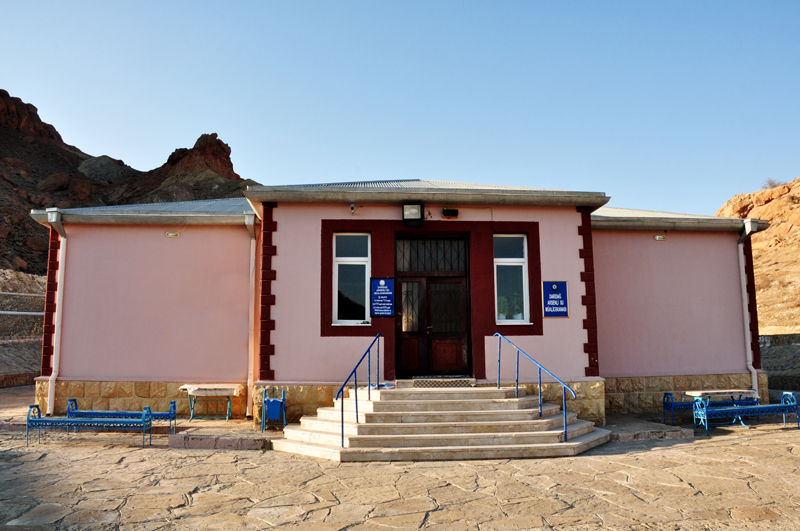
“Daridagh”
Daridagh – is a rare source existing in nature which is included in the carbonated arsenic mineral waters. It is situated at 8 km distance in the North from the city of Julfa. The investigated reserves are 500m3. It is of highly mineralized (temperature -520C) 21 g/l carbonated CO2 – 1,5 g/l chlorite – hydrocarbonated – natrium composition. At the same time, it contains extremely more borium, iodine, bromine, stronsium and lithium. It is advisable to drink in gastroentric, joint diseases. It has an idespensable importance to take a bath in peripheral nerves diseases.
"Nahajir"
Nahajir - is a health resort place with treatment importance in the North-East of the city of Nakhchivan. It is situated in the slopes of the Nahajir mountain. The base of the health resort reserves comprises carbonated water sources (1,3 g/l free carbonate) magnesium-hydrocarbonated-natrium and water sources with 6 g/l mineralized degree. It gives good results in digestive organs diseases and anaemia illnesses.
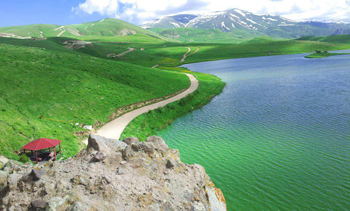 “Batabat”
“Batabat”
Batabat is the climate health resort zone of healing importance situated in 1700m above the sea level, in the slopes of the Lesser Caucasus at 6 km distance in the North-East from the city of Nakhchivan.
The climate is subtropical, snowy, mild winter, dry and not very hot summer. Together with the climate condition (aeroheliotherapy), the main healing means are the carbonated, hydrocarbonated, calcium-natrium-magnezium water sources with 0,5 g/l mineralized degree. The right water is drunk in treating gastroentric diseases. The lake with sweet water, mild climate, good scope view, and very rich flora belonging to alp meadows impress the human very highly.
"Gomur"
Gomur is a high above mountain climate station. It is situated at 75km distance of the city of Nakhchivan, 1700m above sea level.
Very rich mineral water deposits with carbonated salt-alkali composition were discovered here. The climate of this place is mild-cold: winter is mild and summer is cool. The Gomur health resort zone is of special importance in treating the nerve systems functional diseases, tiredness, gastroentirc and respiratory diseases.
"Sharur"
The Sharur springs are situated near the macadam road, in the South-West of Sirab village. The power of springs (daily output over 1mln liters) gives an opportunity to bild a healing complex thanks to the waters with carbonated hydrocarbonate-chloride-natrium and with rare microcarbonated complex composition.
The rich mineral water sources of Nakhchivan have opportunities to gain advantages in the world market.
Climate – The climate of Nakhchivan is sharp continental. A dry subtropic climate type is met in the territory of Ordubad. The absolute minimum temperature is 310C (Darvishlar), while the absolute maximum temperature is 440C (Julfa)
The climate of the autonomous republic is divided into 5 types.
1. The mild hot half desert and dry field climate of summer covers along the Araz lowlands and partly short mountainous areas (600-1400m). |The annual average temperature is 10-140C, the annual average precipitation is up to 300mm, and possible evaporation is 1200-1400 mm.
2. The half desert and dry field climate of dry winter covers the above part of the lower mountainous zone and lower part of the middle mountainous zone (1100-1600 m). The annual average temperature is 8-100C, the annual average precipitation is 300-350mm, and the possible evaporation is 800-1100mm.
3. The cold half desert and dry field climate of dry summer covers the above part of the middle mountainous zone (1600-2600m). The annual average temperature is 6-100C, and the annual average precipitation changes between 400-800mm.
4. The cold climate of dry and cool summer only spread in the South-West slope of the Zangazur chain, in the central strip of the height mountainous zone of 2600-3200m height. The annual average temperature is 1-30C.
5. The mountainous Tundura climate covers the height mountainous tops (over 3200m) of the area. The annual average temperature is 3-80C.
The absolute minimum temperature is -310C (Darvishlar) in the region, but the absolute maximum temperature is +440C (Julfa); it is also minimum and maximum temperature in the territory of the Azerbaijan Republic. The annual average speed of wind is 2/4 m/s. The annual precipitation is 200-300mm in the lowlands along the Araz river, but in the highest mountainous places it is 500-800 mm.
The Flora and Fauna - The rare fauna and flora of Azerbaijan are found in Nakhchivan Autonomous Republic. Though the territory of Nakhchivan Autonomous Republic comprises 6,2% of the territory of the Azerbaijan Republic, for its kind variety its flora comprises around 60% and fauna 56% of the country. 7 climate zones out of 11 existing in the world are met in Nakhchivan Autonomous Republic. There are about 3000 plant species, 373 animal sorts, 226 bird kinds in Nakhchivan Autonomous Republic. Rare fauna and flora are protected in the Ordubad State Reservation, Zangazur National Park, Shahbuz State Nature Reservation and along the Araz State Nature reservation.
The territory of Nakhchivan Autonomous Republic consists of rich flora and various plants. The flora of Nakhchivan Autonomous Republic is rich compared with other botanic-geographic regions of Azerbaijan. 2782 kinds of supreme plants are met in this region. They, in their turns assembled in 773 species and 134 families. 68 of these kinds are cultivated. Wild plants possess 123 families and 697 species. 732 kinds flora are met in the lowlands along the Araz river, 1326 kinds in the middle mountainous and 640 kinds in the highest mountainous areas. The following plants and their types in Nakhchivan Autonomous Republic are divided into –deserts and halfdeserts; friganoid and bozgir plants; high pasture, subalp and Alp meadows, Alp piles; woods, oasis, along river small woods; deposit and rock plants, water march plants.
The territory of autonomous republic is distinguished from the other regions of Azerbaijan according to its natural condition and richness of fauna. The kinds of animals and its number comprises 60-80% percent of the Azerbaijan fauna. The fauna of the autonomous republic has been investigated since the second half of the 19th century. The scientists have defined 813 butterfly kinds, 134 kinds of sovca, 4 kinds of insects, 3 kinds of runaways, 4 kinds of praying mantis, 67 kinds of straight wings. 75 kinds of grasshoppers, 480 kinds of halfhardwings.
29 kinds of fish belonging to the bony fish class were discovered in the rivers and lakes of the autonomous republic.
There are 6 kinds of amphibians and 19 kinds of reptiles in Nakhchivan Autonomous Republic. 218 kinds of birds out of 366 registered in Azerbaijan live in the territory of the autonomous republic. 61 kinds of mammals are known in the area. 40 kinds of vertebral animals out of 350 kinds living in the autonomous republic were included in the “Red book”.


